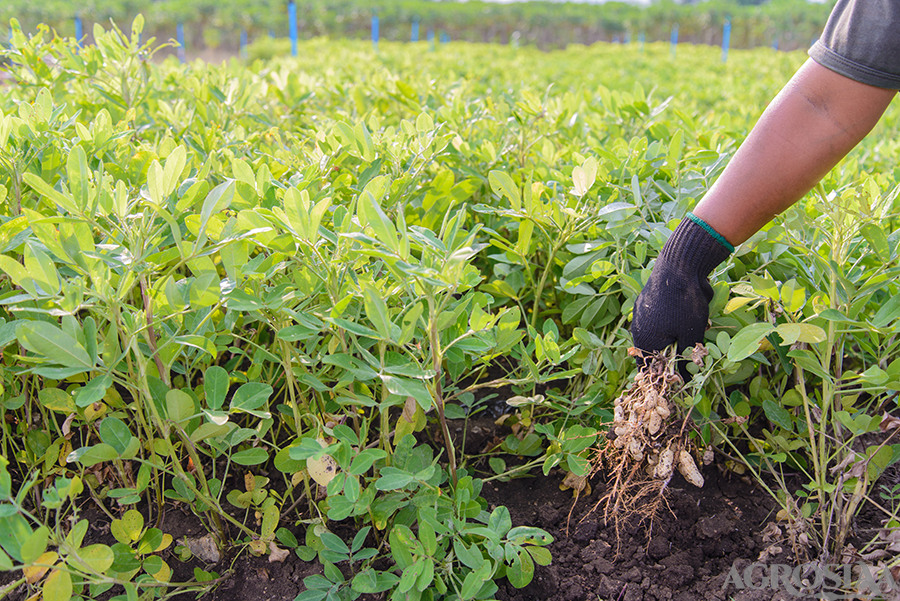Bhuimug
Leguminoceae
Arachis hypogea
JL 24(Phule pragati), SB-11, TAG-24, TG-26, ICGS-11, JL-286 (Phule unap), JL-220 (Phule vyas), TPG-41, JL 501,l ICGS-10, 44, Koyana (95-B), TMV-10
Kharif, Rabi and summer seasons for sowing of groundnut crop.
Groundnut is tropical crop required long and warm season for growing. Groundnut is day neutral crop are adversified in low light intensity during early growth and flowering period. Average rainfall n500-1000 mm. Optimum temperature is 27-32 0c in grown and reproductive stage 24 to 27 0c. for pod growth maximum temperature at 30-35 0c . At maturity cool night is best.
Soil should be well drained , light, loose , friable sandy loam, rich in calcium, pH should be range between 6 to 6.5. Groundnut is acid tolerant crops. Heavy clay soils are not suitable for groundnut cultivation.
Groundnut is deep rooted crops looking to pod development. Deep ploughing should be avoided to avoid deep pod formation. Shallow ploughing is given by 2-3 harrowings. Friable and loose seed bed required. Before last harrowing apply 10 tons FYM/ha.
1) Thiram @ 5 gm /kg of seed or 5 gm of Trichoderma per kg for root rot or bud necrosis.
2) Rhizobium is used for leguminous crops for enhancing the nitrogen fixation bacteria to increase the atmospheric nitrogen in soil.
3) Phosphorous solubilizing bacteria @ 250 g/10 kg of seed for availability of P2O5 in soil increases.
Sowing method for groundnut is dibbling or drilling with two bowl seed drill.
Sowing method for groundnut is dibbling or drilling with two bowl seed drill.
Kharif= 15 th June to 7 th July
Rabi = October to November
Summer= Iind fortnight of January to 1st fortnight of February
Bunch type
Distance between two rows is 30 cm distanc ebetween two plant is 10 cm
Semispreading type
Distance between two rows is 37.5 cm distanc ebetween two plant is 15 cm
Spreading type
Distance between two rows is 45 cm distanc ebetween two plant is 15 cm
-
Appropriate seed rate is required for groundnut is
1) Bunch type = 100 kg/ha
2) Semispreading type = 90 kg/ha
3) Spreading type = 80 kg/ha
First hand weeding at 20 days after sowing and second hand weeding is after 35 days after sowing.
At the time of last harrowing add 10 tons FYM per hectare. 25 kg : 50 kg : 0 NPK /ha or 100 kg DAP or 250 kg /ha of Gyp[sum. Fe- soil application of 25 kg FeSO4 or 1 % FeSO4 foliar spray to avoid iron chlorosis formation. Zn= soil application of 25 kg ZNSO4 foliar spray B= soil applicatiob of B @ 5-10 kg /ha.
In case of kharif there is no need of irrigation water requirement is 40-45 ha.cm
Critical growth stage of groundnut for irrigation
1) Branching : 20-30 days after sowing
2) Peg formation: 40-45 days after sowing
3) Pod formation: 60-65 days after sowing
Chemical weed control in preplant incorporation of Fluchloratin @ 0.5 – 1.0 ai. /ha in 500 liter in water. Preemergence of alachlore 1-2 kg a.i /ha in 500 liter of water.
1) Tikka disease and Rust- spray Mancozeb @ 1250 gm in 500 liter of water .
2) Fungal disease of Groundnut- collect and burn the plant debris. Dust 300 mesh sulphur @ 20 kg /ha . Spray 1% Bordeaux mixture , grows disease resistance varieties.
Leaf miner , leaf eating catter piller-spraying of Cxypermethrin @ 250 ml or decanethrin @ 500 ml or Quinolphos @ 1000 ml in 500 liter of water. Thrips, Aphids, Jassids- spraying dimethoate @ 500 ml methyldemeton @ 400 ml in 500 liter of water.
-
Optimum moisture in the soil at harvesting vapsa condition is the ideal condition for harvesting.
Generally harvesting is carried out by uprooting the vines by hand, with the help of kudali, running the harrow plucking the pods and remove the dirt particles and dried.
Average yield in Kharif season= 18-20 Q/ha
Average yield in Summer season = 25-30 Q/ha
Podes are dried in sunlight and then stored in gunny bags or polythene bags.
Eating purpose, Oil Industry, Chikki making, Oil cake
1) Groundnut oil is manufacturing of vegetable oil or Vanaspati ghee.
2) It contain oil 48.6 % Protein 26 % and 18 % contain CHO.
3) Groundnut seed is rich source of oil b vitamin, B12. It is good source of riboflavin, thiamin, nicotic acid and vit E.
4) It contain minerals like P, Ca, Fe .
5) Oil cake is used as organic manure and animal feeds. This contain 7.8 % N, 1.5 %P, 1.5 % k.
6) Fresh pods immidiately after harvesting are boiled and used as eating purpose.
7) Groundnut is consumption of different products like seed, chateny, powder, butter purpose.
8) Groundnut green and dry vines are used for feed for animal.
9) Shells are used as fuel purpose in rural area and manufacturing the coarse board.
10) Used as totational crop because to fix atmaopheric N2 in soil.
11) It is used as cover crops to protect the soil from erosion.
After drying pods remove shell with the help of machine or manually. Harvested produce packed in gunny bags or polythene bags.
India, China, USA In India Gujarat, Andhra Pradesh, Maharashtra, Rajasthan.
Oil Industries
-
-










